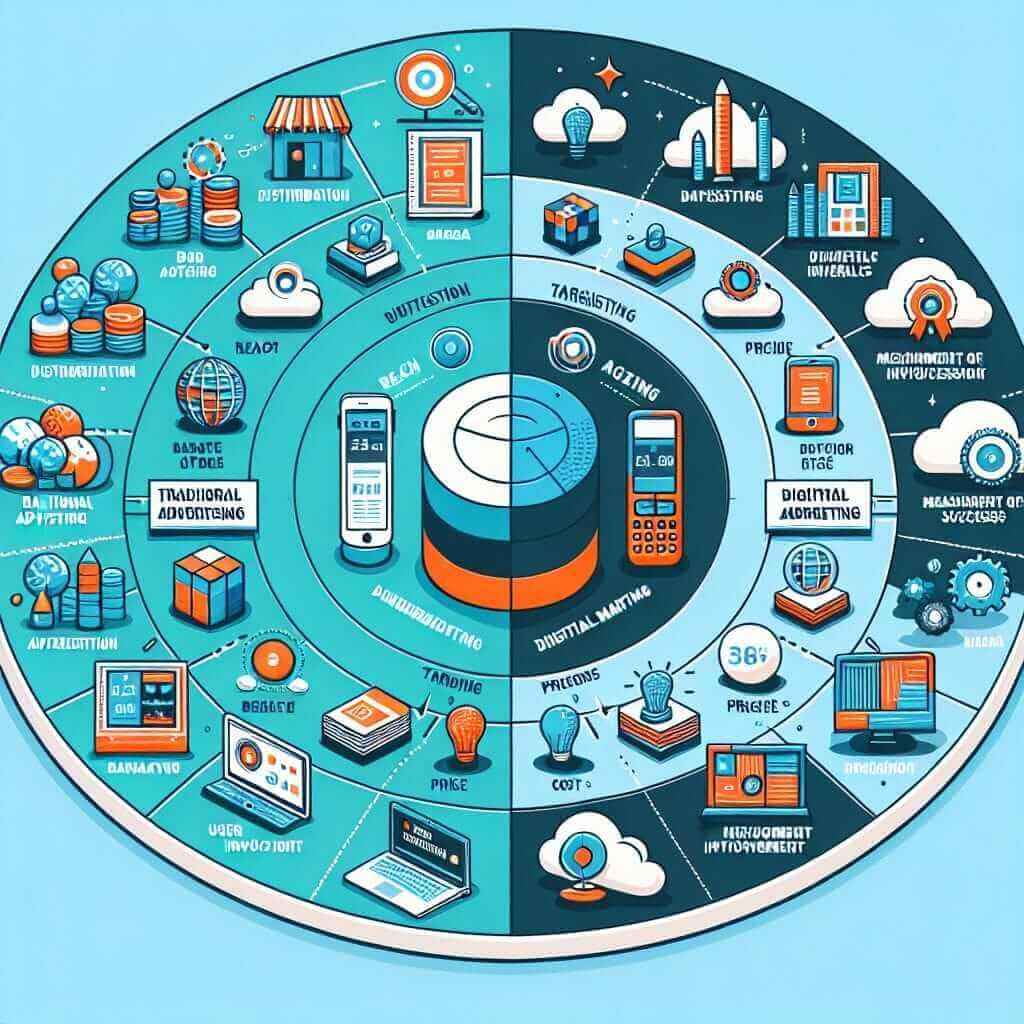The impact of digital marketing on traditional advertising is a hot topic in IELTS Writing Task 2. It’s crucial to understand what each term means and how they intersect:
- Digital Marketing: Utilizing online channels like search engines, social media, email, and websites to reach target audiences.
- Traditional Advertising: Conventional methods such as print media (newspapers, magazines), broadcast media (TV, radio), and outdoor advertising (billboards, flyers).
This topic often appears in the exam, reflecting its relevance in today’s world. Expect questions about the advantages and disadvantages of both approaches, their impact on consumer behavior, or the future of advertising in a digital age.
Here are some potential IELTS Writing Task 2 questions you might encounter:
- To what extent has digital marketing replaced traditional advertising? Discuss both views and give your opinion.
- Some people believe that traditional advertising is obsolete in the digital era. Do you agree or disagree?
- Analyze the benefits and drawbacks of both digital marketing and traditional advertising. Which form of advertising do you think will be more effective in the future?
Sample Essay: Digital Marketing vs. Traditional Advertising
Let’s choose the first question to develop a sample essay:
To what extent has digital marketing replaced traditional advertising? Discuss both views and give your opinion.
Essay Analysis
This question requires a balanced discussion. You need to acknowledge both sides of the argument – the extent to which digital marketing has supplanted traditional advertising and the areas where traditional methods still hold value. Your opinion should be clearly stated and supported by evidence.
Sample Essay
In the current digital landscape, the advertising industry is undergoing a significant transformation, with digital marketing gaining traction at an unprecedented pace. While some argue that this phenomenon marks the demise of traditional advertising, others maintain that conventional methods retain their relevance. This essay will delve into both perspectives before concluding that although digital marketing is becoming increasingly dominant, traditional advertising continues to serve its purpose in specific contexts.
Proponents of digital marketing replacing traditional advertising highlight its unparalleled reach and targeted approach. Unlike traditional media, which often targets a broad audience, digital channels allow businesses to connect with consumers based on demographics, interests, and online behavior. This precision targeting minimizes wasted resources and increases the likelihood of conversion. Moreover, digital marketing offers real-time analytics, enabling companies to track campaign performance and make data-driven adjustments, a level of insight unavailable in traditional advertising.

However, dismissing the enduring power of traditional advertising would be premature. Despite the rise of digital, traditional media like television, radio, and print still command a sizable audience, particularly among older demographics. These platforms often offer a sense of credibility and trust that many online channels lack. For instance, a full-page advertisement in a reputable newspaper can lend an air of legitimacy to a brand. Furthermore, traditional advertising can be highly effective in creating emotional connections with consumers through powerful storytelling and impactful visuals, something digital marketing sometimes struggles to replicate.
In conclusion, while digital marketing has undoubtedly revolutionized the advertising industry, it is an overstatement to declare traditional advertising obsolete. Digital marketing excels in targeting, measurability, and cost-effectiveness, while traditional methods retain their strength in building brand credibility and fostering emotional engagement. Ultimately, the most effective advertising strategies leverage the strengths of both approaches to create a holistic and impactful campaign.
Word count: 325 words
Writing Tips
- Vocabulary: Use a wide range of vocabulary related to marketing and advertising. Avoid repetition by using synonyms and paraphrasing.
- Grammar: Pay attention to verb tenses, especially when comparing the past and present. Use complex sentence structures to demonstrate grammatical range and accuracy.
- Structure: Follow a clear structure – introduction, body paragraphs (presenting both sides of the argument), and a conclusion that summarizes your main points and states your opinion.
- Examples: Use relevant examples to support your arguments. This will make your essay more persuasive and engaging.
- Linking Words: Use a variety of linking words and phrases to connect your ideas and sentences smoothly.
Useful Vocabulary
- Target audience (n.) /ˈtɑːrɡɪt ˈɔːdiəns/: The specific group of people that a product or service is aimed at.
- Conversion (n.) /kənˈvɜːrʒən/: The act of persuading someone to buy something or to start using a service.
- Demographics (n.) /ˌdeməˈɡræfɪks/: Statistical data relating to the population and particular groups within it.
- Credibility (n.) /ˌkredəˈbɪləti/: The quality of being trusted and believed in.
- Engagement (n.) /ɪnˈɡeɪdʒmənt/: The state of being involved with something.
- Obsolete (adj.) /ˈɒbsəliːt/: No longer produced or used; out of date.
Conclusion
The interplay between digital marketing and traditional advertising offers a rich field for discussion in the IELTS Writing exam. By understanding the key arguments, using specific vocabulary, and crafting a well-structured essay, you can effectively tackle this topic and achieve a high band score. Remember to practice writing essays on this and similar topics to improve your writing skills and confidence.
Other potential IELTS Writing Task 2 questions within this theme:
- What are the ethical implications of targeted advertising in digital marketing?
- How has the rise of social media influencers impacted traditional celebrity endorsements?
- Discuss the role of data privacy in the context of digital marketing.
For further insights on related subjects, you can explore the influence of technological innovation on business practices or the impact of social media influencers on consumer behavior.